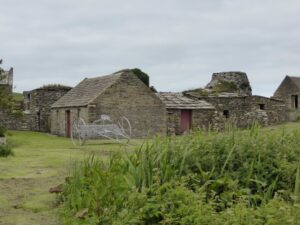
I’ve been working with a well-established travel company who want to develop a tour of Orkney for their guests. It is a fun thing to do, but it is more complex than you might think. To be honest, once the tour is up and running, being a guide-lecturer is pretty much of a doddle. You are paid to visit first-rate sites with which you are familiar and chat about them with a bunch of interesting people. The conversation usually ranges widely and friendships are formed. It is always an intense experience, but it is one that I enjoy.
There are, however, several different elements necessary to build a tour from scratch and it is important not to leave any of them unexplored. First of all, of course, it is necessary to select the sites. In a place like Orkney that is not as easy as it may seem. There are so many interesting sites here that it can be more a matter of which visits to leave out. Some don’t have adequate parking. Others don’t lend themselves to coach tours (locations where only two or three people can enter at a time for example).
Then you need to group those sites into meaningful days, and decide in which order the days should come. First time visitors to Orkney are always keen to see the World Heritage sites so I tend to suggest that they come first. It also makes sense to visit Skara Brae before the other Neolithic sites because that is where you get a glimpse of the everyday life of the average Neolithic islander. Wherever they came from in Orkney, the people who knew the stone circles, buried their dead in the tombs, and experienced Ness of Brodgar, their lives were rooted in the domestic routine that was played out in communities of houses similar to those at Skara Brae. Similarly, it is hard to understand the significance of the Renaissance vision of Earl Patrick Stewart as expressed in the Earl’s Palace in Kirkwall, if you have not explored the northern foundations of life in Orkney in preceding centuries under the Norse Earldom at sites like the Brough of Birsay or Quoygrew.
Finally, it is, of course, important to combine outdoor sites with the museums. But we have more museums than many people think – which to include? The Orkney Museum in Kirkwall holds the artefact collections that provide colour to the framework set by the archaeological sites. The two farm museums offer an atmospheric background to more recent times, Stromness museum has an eclectic collection that ranges widely with something for all interests, the Scapa Flow visitor Centre at Lyness holds fascinating material related to the two World Wars and in particular the scuttling of the German Fleet, and the Pier Arts Centre houses an important collection of art, not to mention local and traveling exhibitions. And that is not all of them.
There is an order to things.
But that is not all. With the basic framework comes the nitty-gritty. How long should we spend at each site? Where should we have lunch? Where should we stay? What about evening meals? Lectures? Free time? It is like doing some sort of immersive jigsaw puzzle. Luckily, I don’t have to work it all out myself, there are those much more experienced than I in the logistical detail. My job is mainly to advise on presenting 10,000 years of island culture at its best. It is not all archaeology – it is also about helping people to understand Orkney today, and the way in which the past has contributed to the present. It is nice to try to sneak in little things that others might miss, or off-the-beaten-track sites that you might not access if you were not in an organised group. Visiting remote and small places like Orkney can be quite daunting for people who are not sure of the infrastructure up here which is why it can be easier to come on a tour.
And all of this is without consideration of the current debates as to whether, or not, tourism is ‘a good thing’. That, I think, would be a whole new blog post and I’m not going to get drawn into it here.
In this case, anyway, I think we have done a good job. I’ve enjoyed thinking about how to present Orkney so that people really have a fun, and interesting holiday. They are not going to see everything, but hopefully they will leave feeling fulfilled and with the knowledge to return one day should they wish to explore other parts of the islands.
You must be logged in to post a comment.